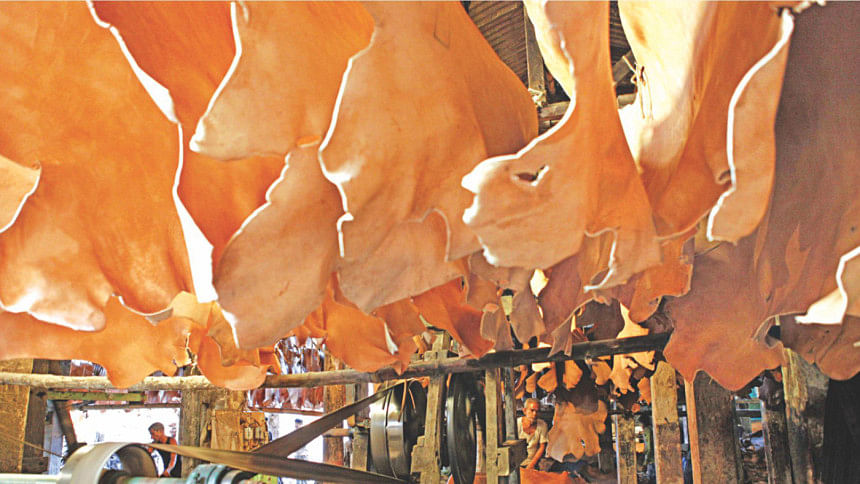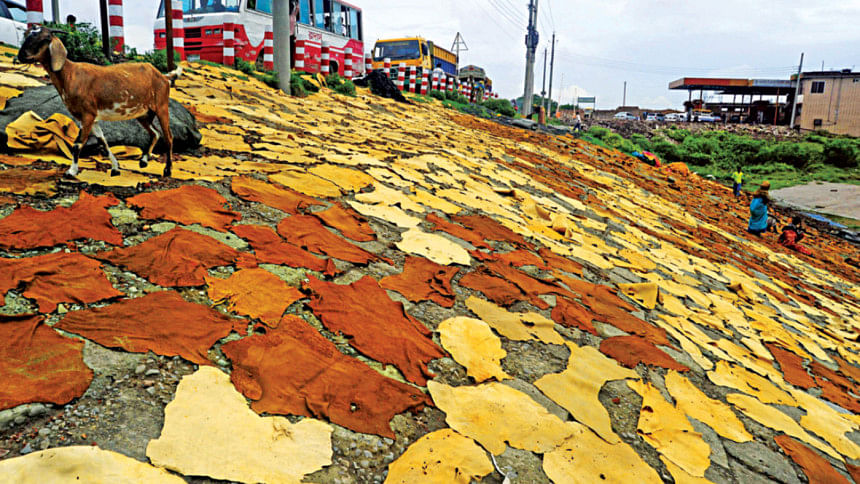Rawhide market braces for crisis

India doesn't export and Bangladesh doesn't import, yet the age-old cattle trade goes on and it accounts for nearly $1 billion business a year. Up against cow slaughter, the ruling BJP in India has recently choked the illegal supply channels to Bangladesh. New dynamics that followed: RSS guarding the borders, border guards becoming suddenly reluctant to be partners in the crime and smugglers looking for other goods. With the clandestine business almost coming to a grinding halt, The Daily Star, in its 3-part series, focuses on the impact on life and livelihood across the border.
With Indian cattle supply drying up the local leather industry is feeling nervous about a short-term crisis in rawhides.
Even though they depend largely on local rawhides, yet tanners fear that they won't be able to get even half of their requirements this year.
The shortage is likely to result from fewer Indian cattle coming to the Eid market.
"We are anticipating that there will be a shortage for 20 to 25 lakh cattle during this Eid, and we won't be able to collect those rawhides," said Md Shaheen Ahmed, president of Bangladesh Tanners Association.
Mazakat Harun Manik, senior vice-chairman of Bangladesh Tanners Association, said, "It means price of local cows will go up in the Eid market and rawhides prices may increase locally."
If the prices upswing is abnormal, then it might create a crisis in the industry, he said.
Ali Hossain, chairman of Bangladesh Hide and Skin Merchants Association, said the situation might worsen during this Eid if Indian cows were not allowed in.
"The shortage could turn into a crisis," he said, requesting the government to sort out the issue through talks with India as soon as possible.
Some industry insiders are however hopeful that the crisis would not be that severe due to the weak euro, dropping demand, and prices in international markets, and a good stock of rawhides.
Although the dried up flow of cattle from India worries tanners, a majority say they have adequate stock and finished leather to deal with the situation.
Many tanners and leather goods manufacturers still have in stock almost half the rawhide they had collected last year, including last year's Eid-ul-Azha.
Abu Taher, chairman of Bangladesh Finished Leather, Leather Goods and Footwear Exporters Association, thought that the shortage of Indian cattle would not put any major impact on hide collection during this Eid, as they have enough from last year.
"We are yet to sell the last year's lot, as demand for leather and leather goods in the world market is on the decline," he said.
"They [foreign consumers] now prefer to buy non-leather goods, as they are yet to completely recover from the recession," said Taher, who has already stopped collecting hides for his company Fortuna Group.
The demand and prices are declining especially in the European markets due to the weak euro, which lost 25 percent of its value against the US dollar since its launch.
The euro is likely to be weak indefinitely and the currency will not gain value without sweeping economic reforms across the European Union, according to the Organisation for Economic Cooperation and Development.
Sixty percent of the leather produced here go to the European Union countries, 30 percent to Japan, and 10 percent to other countries of the world, according to industry insiders.
The price of a square foot Bangladeshi leather has dropped by over 10 percent in the markets, and the declining demand also resulted in falling exports, industry people said.
The leather export fell 21.36 percent to $397.54 million in last fiscal year, from $505.54 million a year ago, according to Export Promotion Bureau of Bangladesh.

However, exports of leather products increased by 3.79 percent to $249.16 million in the last fiscal year, while the export of leather footwear rose by 27.81 percent to $483.81 million.
Mizanur Rahman, executive director of Samota Leather Complex, said the Indian restrictions might create a crisis in the short-term.
Almost all the tanners in Hazaribagh area had collected rawhides comparatively at higher prices last year. But soon after Eid, leather prices in the international market started declining, he said.
"I could sell half of my rawhides since then and the rest are still in stock," he said, adding that the situation was more or less the same for other tanners in Hazaribagh.
"The foreign buyers, especially the Europeans, are offering 15 to 20 cents less for every square foot of leather than they used to. The Italians are offering even less than other Europeans," said Rahman, also treasurer of the Bangladesh Tanners Association.
In a recent letter to the livestock ministry, he also urged the government to encourage local cattle farming.
Around 70-80 lakh cattle are slaughtered throughout the year for meat but around 30-40 lakh are sacrificed during Eid-ul-Azha alone, industry insiders estimate.
They say that around 60 lakh calves are born a year in Bangladesh, and the country has to depend on about 20 lakh cattle from India to meet demand.
Some 21 lakh cattle were brought in from India in 2013-14, according to data from the National Board of Revenue.

 For all latest news, follow The Daily Star's Google News channel.
For all latest news, follow The Daily Star's Google News channel. 



Comments